Zoos are one of those concessions to the limits of consciousness I both regularly support & by which I am slightly horrified. Humans don’t have enough empathy to extend to all the furry & scaly creatures out there w/o caging them up & storing some nearby to remind us they’re out there & much more intriguing & compelling than on TV. On the other hand, because of this they are our jesters when we go to the zoo, & it’s really rather embarrassing. These observations come courtesy of the Nashville Zoo at Grassmere. Not an especially great zoo, but we make a habit of going to the zoos on most of our family vacations, especially since I began teaching physical anthropology & primatology courses. I look for great photos for PowerPoint slides, anecdotes about zoo personalities, or research opportunities for students.
The Nashville Zoo only has white-handed gibbons, a few siamangs, ring-tailed lemurs, and Schmidt’s guenons. Aside from the guenons, stuff pretty much every zoo and even roadside attractions carry, & the guenons were off exhibit on our visit. We got one decent picture of a female gibbon. Even better perhaps, the siamangs were vocalizing when we arrived, & I tried to capture some of the audio on my smartphone, but I was also picking up some of the “Mommy, mommy, look at the kitties.” “No, sweetie, those are monkeys. Do you see how fast they swing through the trees? If you keep watching, maybe they’ll fall.” Court jester stuff.
I have been trying to set up access to enable a student to do voice attractiveness research at a local zoo, but one of the big problems is findings a zoo habitat that is conducive to recording non-human ape vocalizations w/o picking up human ones. The gibbon island at Grassmere is nice, but Nashville is a little far. I have talked about setting something up at the Birmingham Zoo, where I regularly take student groups. This is not research I’ve done before, but some of the voice attractiveness research in The Science of Sex Appeal came out of the Gallup Lab when I was there (e.g., see Pipitone & Gallup or Hughes et al.), & I would be happy to facilitate among non-human primates, as my friends & colleagues there have suggested I try to do, if the right student comes along…
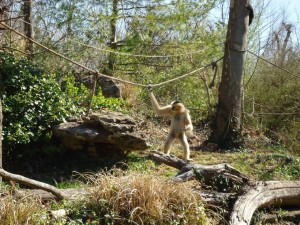
Female white-faced gibbon at Nashville Zoo at Grassmere (photo by Loretta Lynn)
I was disappointed to miss the Schmidt’s guenons, because I’ve never seen them firsthand that I recall, but I found the story about the gibbons interesting. I learned from a zoo volunteer that the female gibbon on display is 43 years old, doing well beyond her 40-year zoo life expectancy. She’s the surrogate mother of the male in the exhibit & did the same for his brother before him, who has been moved on to another facility to meet a lady friend. They both come from a mother in Minneapolis who was violently hostile to her offspring & is not allowed to breed anymore. I wonder if the Mpls unfit mom is an outcome of the period when infants were removed to be bottle fed, under the theory that humans could do a better job parenting than the mothers. This practice undermined the developmental learning of care-taking behaviors for a whole generation of zoo primates, which are not innate, but which even a zoo-born primate can do better than a human if exposed to the behaviors (i.e., “learned”) at a developmentally appropriate age. A baby orangutan was born a few months ago at the Birmingham Zoo to a mother born in this period, resulting in ongoing concern that the mother won’t know what to do (students I took to visit in the fall got inside info on the pregnancy, including this insight, before any news was released to the public).

Baby orang from Birmingham Zoo (photo from al.com)
Most of the zoos we go to are like this, a few primates, a few research opportunites, conditions less than ideal, but, on the whole, worth supporting and visiting. Atlanta, New Orleans, and Bronx Zoos are among the best I’ve been to, but in some ways, they are so cluttered with researchers and even have research built into the structure of the museum, that it’s intimidating to students like mine that are coming out of a program that doesn’t really specialize in primatology. My objective is to encourage local research, making use of what’s available, making it accessible to undergrads from anywhere & with whatever training they’ve managed to get at the time. When I taught at Marist College in Poughkeepsie, which only offers a few random anthropology courses taught by adjuncts, I took students to
Trevor Zoo, which is on the grounds of and owned by Millbrook School, a private high school. The collection is limited, but one of my students got to go into the cage with the brown lemur, which was an enviable treat. The Trevor Zoo personnel had great stories about their Japanese macaques that kept escaping and the Geoffrey and common marmoset that produced a hybrid offspring thru the wire of the cage.

Hybrid common/Geoffrey marmoset from Trevor Zoo (on left--photo by author)
My favorite photo op so far was at the Montgomery Zoo. A male chimp was sitting at the side of the enclosure with a giant erection. I ran over to take photos (creepy, I know–you should see the slides I use when I teach about penis morphology). I was enthused about the possibility of courting/mating behavior & queried the keeper to find out if this was a breeding group. Turns out the males had been neutered to reduce aggression in the group (similar fate befell spider monkey males in Birmingham population). The erection was due to the excitement of being fed. They (the chimp & his erection) were lined up at the side of the enclosure for the keeper to throw fruits & veggies over to them. At the edge, a turtle kept sneaking up & stealing food by pulling it into the water. The chimp kept reaching thru to get it back, not wanting a single exciting morsel to go unsavored.
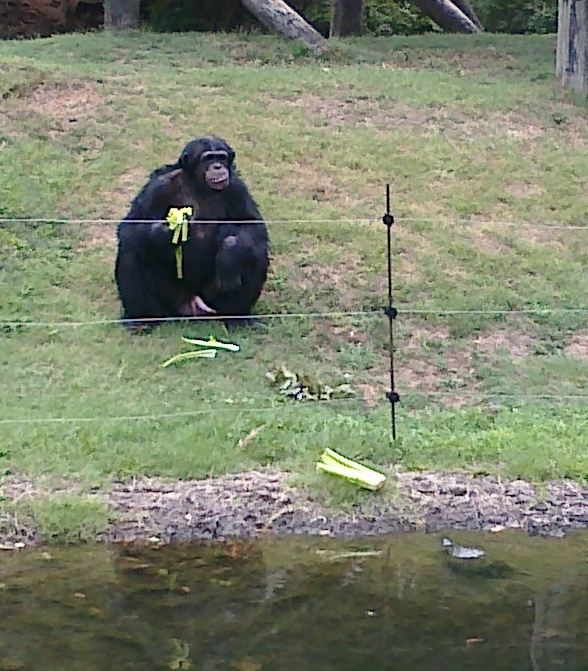
Montgomery Zoo chimp with erection & turtle in foreground coming in for the theft (photo by author).
The most telling anecdote comes from the Memphis Zoo, which I have repeated often to my students. It exemplifies why zoo studies are basically not generalizable outside of zoos but suggests that non-human primates can be just as fucked up & dysfunctional as human ones. They have several gorillas, including one male who’d been introduced not long before we were there a few years ago. He’d come from Gulf Breeze & maybe somewhere before where he’d been isolated most of his life. Memphis wanted to breed him, but he didn’t quite know what to do with the females (gorillas are usually harem maters with a silverback in control). He was so anxious about the whole situation that he had a nervous habit of picking at his own fur & had a bald spot. They had him on Prozac to settle him down, but he was still jumpy around others & stayed inside most of the time.
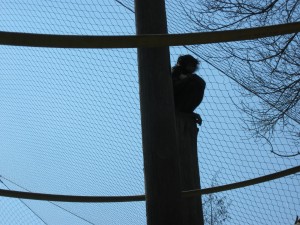
Male bonobo at Memphis Zoo getting some peace from the female gang (photo by author).
While I’ve been trying to get students to take on a voice attractiveness study at the Birmingham Zoo, still the coolest would be a study of bonobo behavior at the Memphis Zoo. Not because it’s an exemplar exhibit–in fact, it’s fraught w/ problems–but simply because bonobos are famously the hippy-free-love species of the non-human primate world & fascinate everyone. I once had a student interested in studying cunnilingus. She suggested promiscuous women would tend to decline it & was trying to figure out a way to test her hypothesis. I indicated she might look at bonobos to get a sense if cunnilingus has an evolutionary history. According to a blog draft for
Scientific American evolutionary psychologist Gordon Gallup sent me in January 2010 but that never seems to have been published, he believes the female vagina would have been a receptacle for the collection of debris, & any oral behavior directed toward it would be limited or not repeated because of primate learned taste aversion. The only data a cursory review I conducted at the time uncovered comes from Frans de Waal (1995) & seems to validate it. Upon visiting the Memphis bonobos, I hoped to establish a relationship whereupon we could film them & test this but found only one male & a gaggle of females. According to the keepers, not only is the intersexual behavior limited, he is rather un-bonobo-like in preferring only one particular female & also preferring–gasp!–
to have sex in PRIVATE! And often the females get aggitated & gang up & take their aggressions out on the male, who escapes to the top of a pole to hide, which is where he was when we visited.
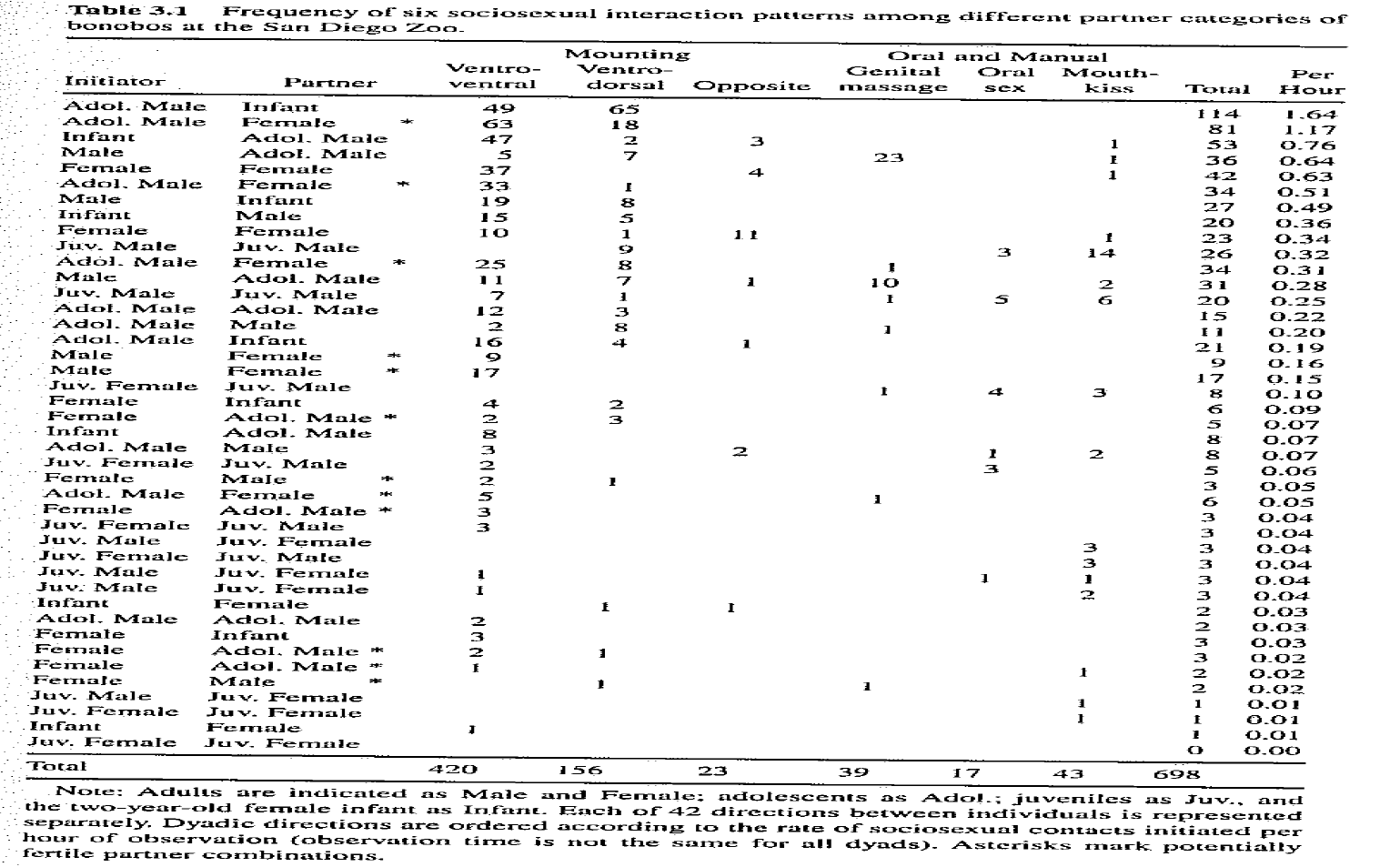
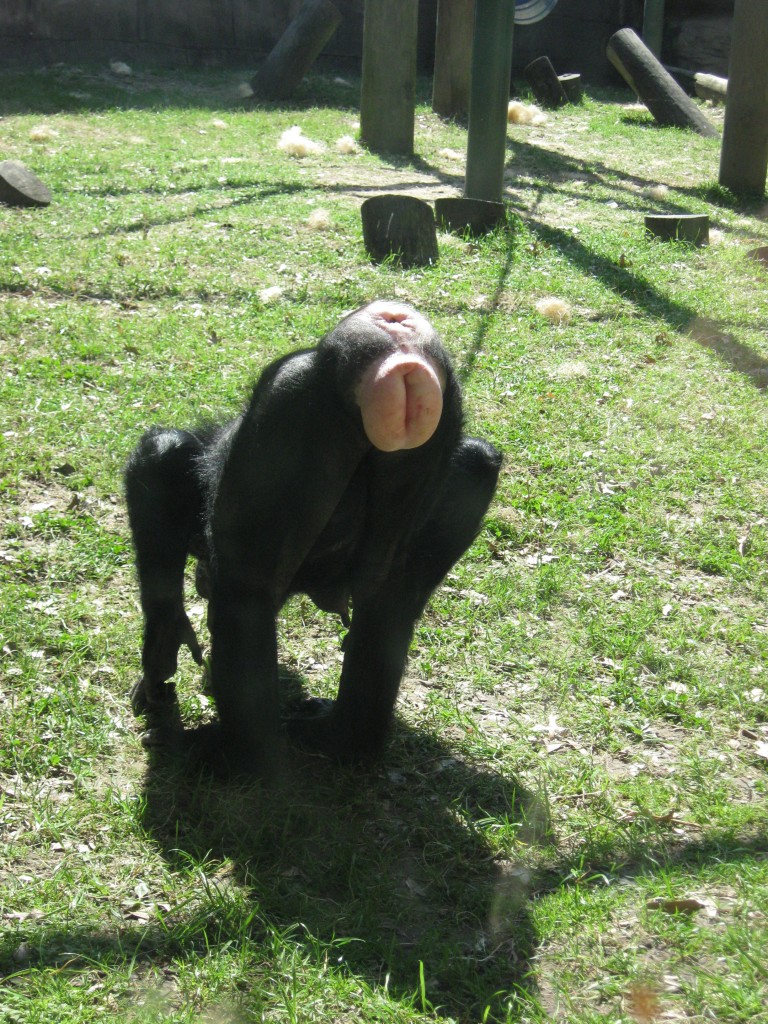
Could debris flow into this vagina given its raised and posterior orientation? (Female bonobo at Memphis Zoo with swollen vagina--photo by author)
Finally, I thought blog fodder might be slim pickings in Nashville (hence my digression to every other zoo in the region & beyond), but we took the kids to the Adventure Science Center & went for the planetarium show. Rather than a star show, they were screening Naturally Selected, complete with an animated Charles Darwin, whom we followed on the H.M.S. Beagle. So much for the naps my father & I were going to take. This was very cool. The film could have dumbed sexual selection down a bit more for folks, but there was an awesome scene of a “caveman” playing an electric guitar as he walks thru history. When he comes across the dodo bird, he clocks it with the headstock of the guitar & the dodo keels over extinct. Hilarious. And the images of Darwin’s epiphanies as imagined on the Beagle on that giant wraparound screen were stunning. Here is a parting look at a surprise sighting of Charles Darwin that I sneaked in the dark, without whom I would not be sharing these prurient details with you.

Animated Charles Darwin in "Naturally Selected" at Adventure Science Center in Nashville, TN (photo by author).









